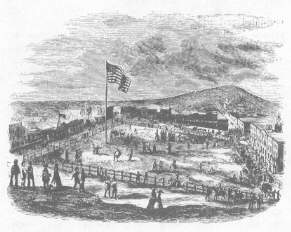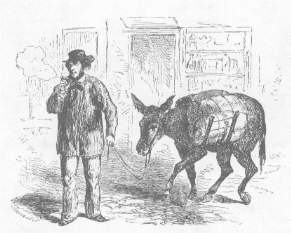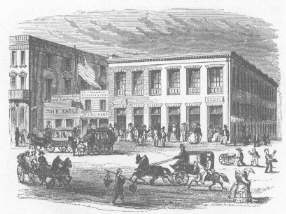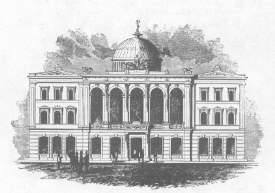
The Annals of San Francisco

The Annals of San Francisco
1854.
JULY.—It is not very necessary to say much more upon the general physical and moral aspect of San Francisco, than has already been said in reviewing its appearance and characteristics at the close of the year 1853. During the six months immediately preceding the date of the present notice, the city passed through a period of great commercial depression. At this time, the extreme mercantile distress is beginning slowly to disappear and the best judges hope that soon again prosperity will visit commerce and all connected with it in San Francisco.
The prices of real estate may, in some few instances, have rallied, but generally they continue much below those readily obtainable at the close of 1853. Many years must pass, and our population be much increased, before those high rates can again be witnessed. While prices of real estate have fallen from twenty to fifty per cent., and in some cases still lower, rents, particularly in the lower or business part of the city, have likewise been considerably reduced. Rents may, perhaps, continue to fall for some time, and yet a fair profit will be left to the owners of house property. The wages of such classes as are employed in building, and the cost of building materials, have both been materially reduced; so that houses can now be erected at much less expense than formerly.
Arising no doubt partly from this circumstance, and notwithstanding the continued and steady fall in rents and the prices of real estate, a great deal of fire-proof and costly building has been carried on since the beginning of the current year. In Stockton, Montgomery, California, Battery and many other principal streets, the old buildings of frame are being gradually pulled down, and magnificent granite and brick structures are rapidly rising in their stead. Vacant lots in the line of streets over all the business part of the city are being covered with substantial buildings. The new Merchants’ Exchange and new U. S. Custom House will be massive and beautiful public edifices. These material improvements are particularly observable upon the northern extremity of Montgomery and Battery streets, at the base of Telegraph Hill. The great depth of water at the wharves in the neighborhood of Clark’s Point, which depth, from the character of the shore and tides, will probably long, if not always, exist, will necessarily make that quarter a peculiarly shipping and mercantile part of the city. Accordingly huge hotels and stores, of the most beautiful and substantial character, are rising up in all parts of the district.
 At
the same time the spirit of improvement is visible over all the other parts
of the city. Many new and elegant buildings of brick and stone, within
the fire-limits, and chiefly of frame beyond them, are continually being
constructed. New streets are being graded and planked, and new public cisterns
formed for the use of the fire department. Even the plaza, the long-neglected,
miserable plaza, the standing reproach and mockery to the boasted “progress”
of our world-renowned city, is being at last, after many years of public
agitation, just a little “improved” by its unkind guardians, the city fathers.
While we write, it is being graded, and is about to have an iron fence
erected around it. The wondrous fabrics of iron and glass, which were to
have turned it, as assuredly they would, if properly designed, into a Crystal
Palace, or rather into a veritable “Palais Royal,” the centre of Californian
taste, luxury, fashion and folly, have been all left to the next generation,
or perhaps only to the still hopeful projectors and the speculative common
council of the next year.
At
the same time the spirit of improvement is visible over all the other parts
of the city. Many new and elegant buildings of brick and stone, within
the fire-limits, and chiefly of frame beyond them, are continually being
constructed. New streets are being graded and planked, and new public cisterns
formed for the use of the fire department. Even the plaza, the long-neglected,
miserable plaza, the standing reproach and mockery to the boasted “progress”
of our world-renowned city, is being at last, after many years of public
agitation, just a little “improved” by its unkind guardians, the city fathers.
While we write, it is being graded, and is about to have an iron fence
erected around it. The wondrous fabrics of iron and glass, which were to
have turned it, as assuredly they would, if properly designed, into a Crystal
Palace, or rather into a veritable “Palais Royal,” the centre of Californian
taste, luxury, fashion and folly, have been all left to the next generation,
or perhaps only to the still hopeful projectors and the speculative common
council of the next year.
The long-desired fortification of the harbor of San Francisco has been at last commenced by the government. The system proposed consists of two lines of batteries inside the entrance to the harbor. Works are already in process of construction on Fort Point and Alcatraz Island. Point San José and Angel Island will, probably, be selected to complete the line of defence. The fortress at Fort Point, which will be the strongest position, will present one hundred and fifteen guns of eight and ten inch calibre, in four tiers. Directly opposite, on Lime Rock Point, a battery of one hundred guns will complete the outer line. The second point of fortification on the inner line is on Alcatraz Island. The shipping battery here will consist of about fifty guns, with batteries on other points yet to be selected. Majors Barnard and Turner, Capt. Whiting and Lieut. Prince are directing the works, which are estimated to cost not less than two millions of dollars. Much doubt is expressed by officers of high rank as to the sufficiency of water defence—many believing that an invading army could readily land any where between San Francisco and Monterey.
The arrivals for the last six months from the Isthmus, exceeded the departures by several thousands. The immigration of Chinese from their own country during the same period, amounted perhaps to five thousand persons of both sexes, while their emigration was slight. The incomers generally departed, after a short sojourn in San Francisco, to the mines; so that the general population of the city may still be estimated at the supposed number inhabiting it at the close of 1853, viz., something over fifty thousand of both sexes and of all ages and nations. The bulk of the great overland immigration does not appear till the fall of the year. The immigration by land for the approaching season is expected to be very great.
The gold mines, the prime source of prosperity and wealth to California, have not for many years yielded better returns to the labor applied to them, than they have done during 1854, so far as the year has elapsed. Every day new and rich auriferous fields are being discovered, while it is found that the old ones, by the application of more careful and scientific methods of extracting the precious metal, continue to supply an ample reward to the miners. But it is not gold alone that has filled up the replete coffers of the State. The quicksilver mines of Alameda County are the largest yielding and most profitable in the world. The only ones that at all compare with them, are those of Almaden in Spain, and Idria in Austria—the latter, one of the old monuments of Roman revenue.
But if the success of the miner has been great, how shall we term the unexampled prosperity of the less romantic tiller of the soil. Crops, throughout the State, have been immense, and have had the effect to reduce the prices of articles of food to a very low figure—far lower than they at present are on the Atlantic. The splendid agricultural resources of the country are only beginning to be understood. A new and equally profitable source of employment has been found in the fisheries on the Sacramento and its tributaries. Salmon, sturgeon, pike, perch, dake, chub, suckers, hard-heads, narrow-tails, &c., are being caught in large quantities. The salmon fisheries are the most important—the fish being far over the average size in the East and ranging from twenty to fifty pounds weight. This business must ere long be one of the most considerable items of the commercial resources of California. Who can tell the limit of the capabilities of this State? All it has accomplished is but preparatory to new exhibitions of power and wealth. Its career lies yet before it. The telegraph has already furnished nerves to the land, by which the impulses of its distant parts are communicated to its great sensorium commune—its brain at San Francisco. Railroads, too, those great arteries by which vivifying nourishment is carried to and from the remotest members of its body, soon will be completed. The Sacramento Valley Railroad from Sacramento to Mormon Island, now projected, will be the pioneer of this improvement. All these facts, together with the extensive shipbuilding carried on at Happy Valley and the Rincon, are preparing the State, and San Francisco particularly, for the great part she has yet to play. Into the past six years, have been crowded the most remarkable and important events that have occurred to our country since its revolutionary birth; and the great pole to which they have all tended is San Francisco. California henceforth will no longer direct her energies on herself. She has attained her majority and donned her freedom-suit, ready to start upon the field of adventure. Foreign relations are engaging the thoughts of citizens and government; hence the ease with which such expeditions as those of the Count de Boulbon and President Walker are fitted up, and the apparent official countenance bestowed on them. Vessels are already departing for Japan, and numerous companies are being formed for foreign traffic. Two of these are in the full tide of success,—one for the importation of ice from Russian America, and the other for the mining of coal in Bellingham Bay, Puget Sound, Washington Territory. The establishment by Congress of the line of mail steamers between San Francisco and Shanghae, and the great treaty with Japan, come fortuitously to meet and give a field for this new and longing spirit. The Pacific between this country and Asia has at last been bridged over California, the Sandwich Islands, Japan and China are the great piers—white sails, and great steamers in continuous lines, will span the intervals. Let the Interoceanic Railway now be built, and San Francisco will then be the great entrepôt of America,—the Tyre of the Pacific,—and California, the most populous, enlightened, and civilized, country in the world.
The project of extending the water-front of the city (already noticed at length), was revived in the Legislature this year. However, political disputes among its supposed patrons, and the parties pecuniarily interested in the scheme, as well as clamant remonstrances of all San Francisco—collectively, in boards, associations and committees; and individually, by public-meetings and signed petitions—had the effect of causing this unnecessary, unjust, and perhaps “infamous” project, to be abandoned. The new city charter was likewise lost in the Legislature. On the expediency of passing this charter as a whole, public opinion was divided, although many of its provisions were generally admitted to be improvements on the existing charter. Many other bills, introduced in the legislative chambers, and which were peculiarly obnoxious to large classes of the citizens, were likewise lost. While we write, the claim of San Francisco is being pleaded before the Board of Land Commissioners, established by the United States, to settle disputed titles in California to four square leagues of land around the city, in virtue of its being, as alleged, a Mexican “pueblo.” Whatever be the result of the claim, many private titles to lots within the municipal bounds will be deeply affected by the decision, and for a time “confusion, worse confounded,” will reign among property-holders. Pending the discussion, many parties are busy over all the four square leagues in question, selecting convenient and desirable “claims;“ and outrages of a daring description are continually taking place between the old settlers and the new squatters, in consequence of these lawless proceedings.
 San
Franciscans can now ask for nothing more on the score of domestic comforts.
Their streets and houses are well lighted by a beautiful gas-light; they
dwell in elegant and handsomely-furnished houses; their tables are largely
supplied with fish, flesh, and fowl from the mountains, rivers and valleys
of their teeming land; they have pure and limpid water for drink and cleanliness,
in no stinted measures; and, finally, they have discovered, near at home,
a boundless supply of excellent stone-coal, sufficient to satisfy all their
demands for fuel, in cooking their meals, melting their gold, driving their
steam-engines and drying their houses in their wet seasons. Bellingham
Bay now furnishes the great demand of the city. Hitherto, all the coal
used was brought, at great expense, partly from Vancouver’s Island and
Chili, but chiefly from such immense distances as Philadelphia, Liverpool,
and other foreign parts. In 1849 and 1850, the townspeople were furnished
with fuel by men, chiefly of the lower class of Hispano-Arnericans, who
cut it from the little gnarled oaks and thick brushwood grown on the low
sand-hills bordering the town—not a stump of which is now to be seen. Wood
and charcoal were brought into the city either on the backs of these men,
or in panniers carried by asses, and two dollars were paid for as much
as a man could carry in his arms. The charcoal men are yet features of
the place. They announce their coming by the ringing of a small bell, and
may be seen in every street offering their little bundles for sale.
San
Franciscans can now ask for nothing more on the score of domestic comforts.
Their streets and houses are well lighted by a beautiful gas-light; they
dwell in elegant and handsomely-furnished houses; their tables are largely
supplied with fish, flesh, and fowl from the mountains, rivers and valleys
of their teeming land; they have pure and limpid water for drink and cleanliness,
in no stinted measures; and, finally, they have discovered, near at home,
a boundless supply of excellent stone-coal, sufficient to satisfy all their
demands for fuel, in cooking their meals, melting their gold, driving their
steam-engines and drying their houses in their wet seasons. Bellingham
Bay now furnishes the great demand of the city. Hitherto, all the coal
used was brought, at great expense, partly from Vancouver’s Island and
Chili, but chiefly from such immense distances as Philadelphia, Liverpool,
and other foreign parts. In 1849 and 1850, the townspeople were furnished
with fuel by men, chiefly of the lower class of Hispano-Arnericans, who
cut it from the little gnarled oaks and thick brushwood grown on the low
sand-hills bordering the town—not a stump of which is now to be seen. Wood
and charcoal were brought into the city either on the backs of these men,
or in panniers carried by asses, and two dollars were paid for as much
as a man could carry in his arms. The charcoal men are yet features of
the place. They announce their coming by the ringing of a small bell, and
may be seen in every street offering their little bundles for sale.
The old round of business, pleasure, folly, vice and crime, still went merrily on. Cases of divorce were nearly as common as cases of drunkenness. Cases of political corruption, of party jobbery, of personal scandal, of ruin by debauchery and gambling, by duelling and suicide, of squatter violence, of robbery and burglary, of assault and murder—why, these were, as before, nearly “as plentiful as blackberries.” It is unnecessary to single out particular cases for remark and reproach. Every day produced a new crop of moral weeds. Still San Francisco contrived to flourish, and its people, in their fashion, to enjoy life. To enforce some measure of outward decency, the common council passed a stringent ordinance regarding houses of ill-fame, making the keeping of them highly penal. This ordinance had the effect, for a time, of closing a few of the most notorious Mexican and Chinese brothels. But it was sought to be enforced against fashionable white Cyprians, who had money enough to employ able counsel to show the intrinsically illegal and tyrannous character of its particular provisions; and then it was found to be utterly impracticable in operation. It seemed all at once to be discovered, that the impurity which was hid by walls, could not be put down by mere legislation.
Duels appeared to be getting more numerous. In the months of May and June several fatal “affairs of honor” took place, and the performance with swords by a couple of Frenchmen varied the monotony of pistols and rifles, and introduced a new fashion for the benefit of future gladiators. Occasionally the death of some well-known citizen would rouse the press and the pulpit to a spasmodic burst of indignation and high-toned sentiment against the foolish and criminal practice of settling personal quarrels by mortal combat. The public looked wise, savage, and virtuous, and talked and drank; then it looked wiser, and, so on, and talked and drank again. Still nothing was done, or perhaps could be done, in the matter. Grand juries occasionally offered a proper presentment on the subject, but their words fell dead. Men in California, who generally want the peaceful, endearing joys of home and flimily, which best make life worth living for, set little value on existence, and in their hot rage will hazard it for the veriest trifle.
 Theatrical
entertainments have never been so well patronized in San Francisco as during
the past half year. A rapid succession of musical and dramatic “stars”
attracted continual crowds to the various “houses.” English, French and
Italian versions of the most noted modern operas were excellently performed
in the Metropolitan and Union Theatres, where four ladies, who each claimed
the rank of prima donna, successively appeared. At the theatres
named, though particularly at the Metropolitan and American, some of the
most celebrated American actors and actresses made their regular nightly
appearance. These, it is said, have reaped a large harvest from their professional
visit to the land and the city of gold. The San Franciscans, truly, are
no niggards with their wealth.
Theatrical
entertainments have never been so well patronized in San Francisco as during
the past half year. A rapid succession of musical and dramatic “stars”
attracted continual crowds to the various “houses.” English, French and
Italian versions of the most noted modern operas were excellently performed
in the Metropolitan and Union Theatres, where four ladies, who each claimed
the rank of prima donna, successively appeared. At the theatres
named, though particularly at the Metropolitan and American, some of the
most celebrated American actors and actresses made their regular nightly
appearance. These, it is said, have reaped a large harvest from their professional
visit to the land and the city of gold. The San Franciscans, truly, are
no niggards with their wealth.
A few of the immense number of daily newspapers, existing at the beginning of 1854, have silently disappeared. In their stead have risen the “Pioneer,” a monthly magazine of great typographical beauty and considerable literary merit; a Chinese journal, and one or two weekly newspapers of fair pretension. The “Mercantile Library Association” has largely increased its stock of books and its members. Churches, schools, and charitable, and other good and laudable associations, flourished contemporaneously with the spread of ignorance, folly and vice, which they have been designed to counteract. A larger female population, and a few more years, and San Francisco may yet be as distinguished for its public and private morals, as it has long unhappily been for the reverse.

